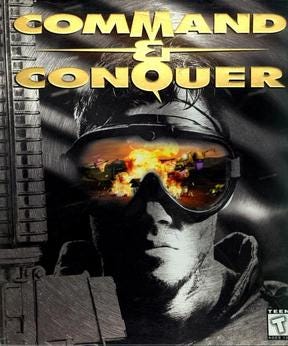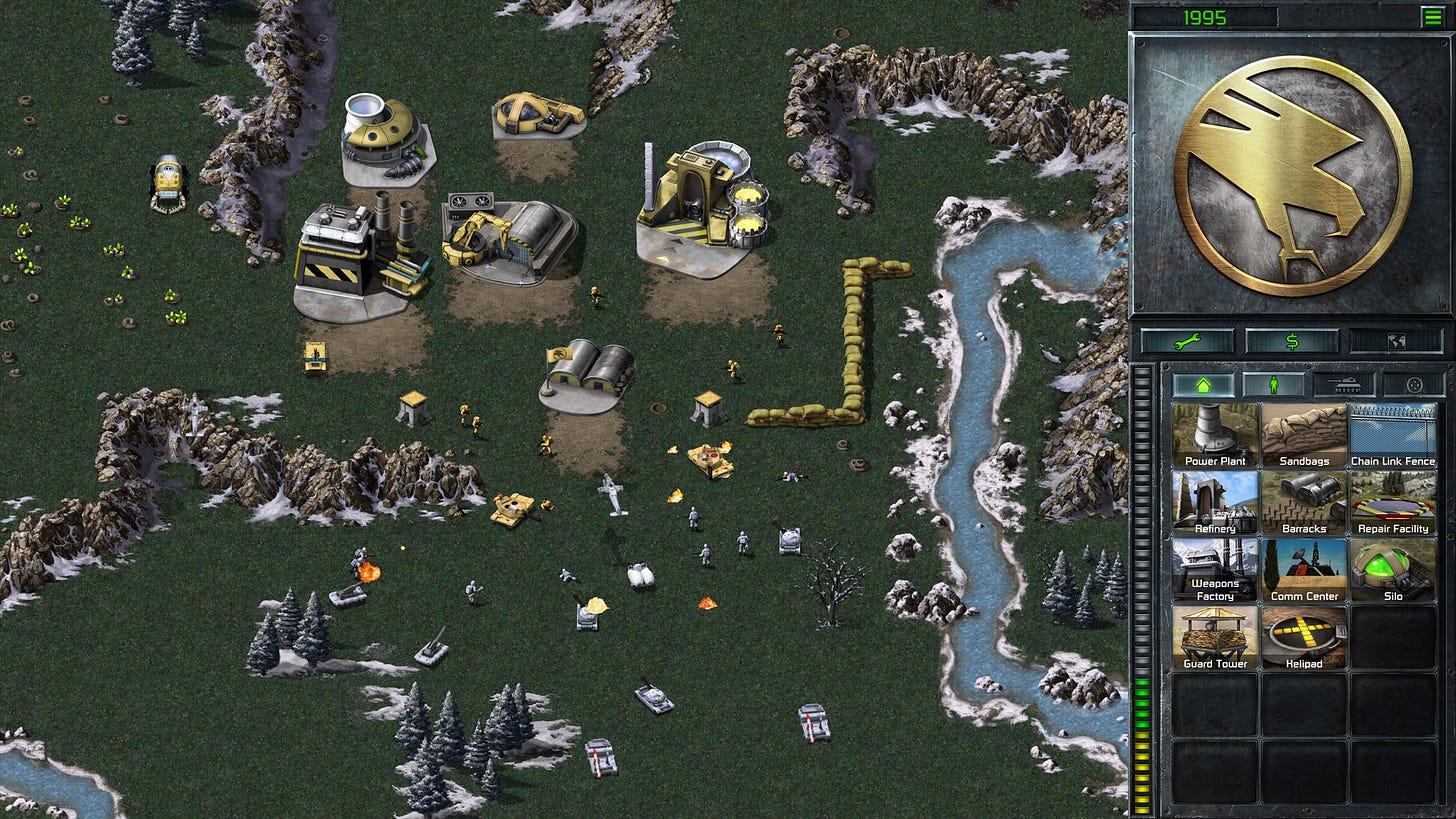RETRO REVIEW: Command & Conquer (1995)
How to do FMV games right!
The year was 1997.
My mother had just remarried and my step-dad and I were starting to find things we could bond over and one thing we both enjoyed turned out to be video games. I’d grown up with consoles but it wasn’t until I met him that I started getting into PC games. Over the years we would pick up many different titles, but the first PC game we played together was the 1995 Westwood Studios classic Command & Conquer.
He would let me play when he wasn’t playing, but the real fun came when he put my mom’s PC (the Packard Bell Legend 822CDTW minitower mentioned in episode 11 of the podcast) on our home network and we would go head to head over the LAN. Now I was 11 at the time, so I sucked. I still kind of suck, but not like I did back then. Once the game’s sequel, C&C Red Alert, came out we moved on from the original, but this one always kept a special place in my heart.
Years later, in the year of our Lord 2022, I picked up the 2020 remaster of the first two games on a Steam sale and it was like reuniting with an old friend. After a couple of days casually playing through the single player campaigns, I was finally able to say that I’d fully beaten the game, so I thought it was time for a formal review.
What is Command & Conquer?
Command & Conquer (henceforth referred to simply as C&C), also referred to as CNC, or C&C: Tiberian Dawn, was a pseudo-realistic sci-fi based real time strategy (RTS) game similar to games like Age of Empires II or Starcraft. The game took place in an alternate reality of the 1990’s when two factions — the UN sponsored Global Defense Initiative (GDI) and the cult-like Brotherhood of Nod — were fighting for control after the appearance of an alien substance called Tiberium had thrown the world into chaos.
It was not only my first real introduction to PC gaming, but it was my first experience with strategy games, and it became the benchmark by which I evaluate RTS games to this day.
The C&C franchise has three distinct series’ to choose from. The main series focuses on the Tiberian Wars but there are also the Red Alert series — a collection of games centered around an alternative World War 2 series of events, serving as a prequel to the main games — and the Generals series set in a more realistic timeline involving the US, China, and a group of extremists in central Asia. This game is the first in the tiberian series and is followed by C&C: Tiberian Sun, C&C: Renegade, C&C3: Tiberium Wars, and C&C4: Tiberian Twilight.
Story
It’s 1995 and a meteor has just crashed in Italy near the river Tiber. As a result, a strange crystal-like substance known as tiberium has begun spreading across the globe bringing into the light an ancient cult known as the Brotherhood of Nod who are interested in harnessing it’s potential to bring about the global reign of their leader Kane. In response, the GDI leadership wage a war to stop Nod and to return stability to the globe.
You choose which faction you want to play as. Choose GDI and fight your way through Europe in order to deliver the final blow to Kane and the Brotherhood. Choose Nod, and you’ll serve the cause as you slowly conquer the entire continent of Africa and force the Western governments to bend the knee.
Sure, it’s more than a little ridiculous, but it’s the 90’s. What do you expect?
Development History
The team at Westwood began development of C&C in 1993 hot on the heels of their notable-at-the-time Dune II which pioneered many of the controls and concepts that would appear in C&C. According to co-creator Louis Castle in a May 2002 Computer & Video Games article, “Command & Conquer was originally a fantasy game with wizards and warriors, but Brett [Sperry - co-founder of Westwood] felt strongly that a contemporary war environment would be more accessible for most people so the game moved into 'modern war' and the C&C; fiction began to take shape.”

The game would be released for DOS in 1995 and the Windows 95 version would release the following year re-titled C&C: Gold. Later that year (1996) the game was ported to Mac OS 7, and over the next year would also be ported to home consoles including the Sony PlayStation, Sega Saturn, and Nintendo 64.
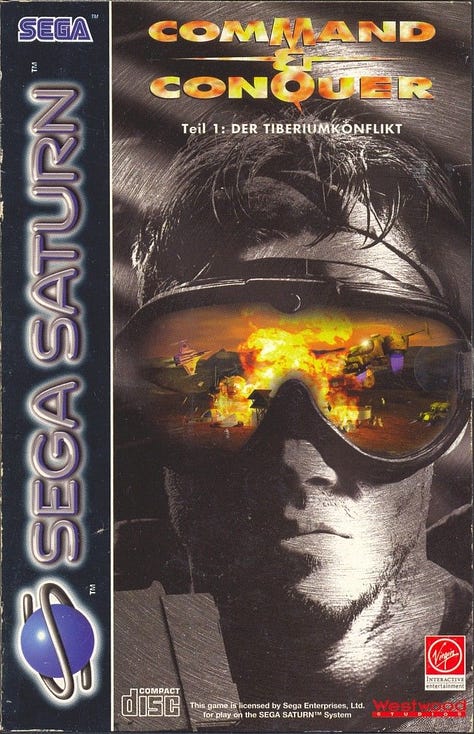
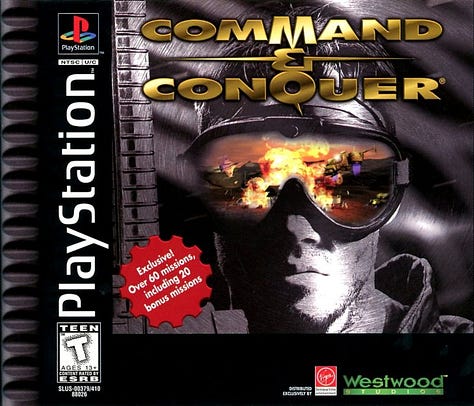
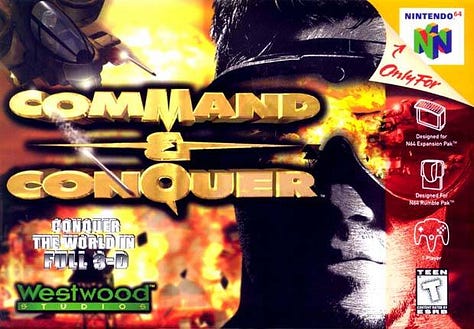
Gameplay
The game handles as well as you’d expect on PC. Most missions see you establishing a base as you build out your army to take down the enemy, clearing every enemy unit and structure from the map before getting the MISSION ACCOMPLISHED message plastered across the screen.
You usually start out with a mobile construction vehicle and a handful of troops and/or vehicles. Once the construction yard is deployed you can build a power plant. Once the power plant is built you get new construction options to work with such as a tiberium refinery and a barracks. The refinery is used to collect and process tiberium which then becomes your money in the game. The barracks build your various soldiers — minigunners, grenadiers, engineers, etc. As you continue to build out your base you acquire different building options which give you more units and special tech/weapons to use in the fight.
While overall I tend to prefer single player games, the C&C games really shine in their multiplayer skirmishes. You can have up to 8 players on a single map and the chaos is a ton of fun to be had.
At some point around 2020, EA even went so far as to release the source code on GitHub to make mods easier to develop, which is pretty fantastic and not something I’d expect from EA.
Graphics
In Game Graphics
Graphically the game is dated, but I’d say it looks better than a lot of games from that era. The environments were created by rendering from digitized photos — not all that dissimilar, to my understanding, from the pre-rendering techniques in games like Donkey Kong Country — giving them a higher quality and greater detail than a lot of other games of the time.
With the release of the Remastered collection, the graphics were upscaled and greatly improved. However, if you’re playing on a CRT monitor like I was and want to get an even more authentic feel to the game, you can revert back to the original graphics in real time by pressing the space bar.
Animations and Cutscenes
The story of the game is told primarily through cutscenes with little CGI scenes interspersed. The CGI is typical of what you might expect from the mid 1990’s, but is honestly a bit better than most of what was out at the time. I mean it was no Toy Story, but it was a lot better than what you got in The Lawnmower Man.
The cutscenes, in all their glory, were primarily full motion video (FMV). This was at the height of the FMV scene of the early 90’s, and while most FMV games were terrible, these scenes really added to the quality of this game. This is because most FMV games would make the video the primary focus, harnessing the benefits of the new CD-ROM media. This left the gameplay to be minimal and not very good. C&C, on the other hand, utilized video along with some good old fashioned camp to drive the story forward while maintaining quality gameplay as the focal point.
Soundtrack
The soundtrack to this game was fantastic. It was a quality blend of Bond-esque orchestral pieces, along with tacky 90’s synth hip hop beats, and solid rock tracks. It created an adrenaline pumping collection that really helped to immerse you in the action and intensity of the gameplay. Below is a sample, the first track on the OST. Click here for the full soundtrack.
Overall Rating & Final Thoughts
Rating: 7.8/10
Gameplay: 8/10
Story: 5/10
Graphics: 7/10
Soundtrack: 9/10
Nostalgia Wild Card: 10/10
Final Thoughts
Command & Conquer remains a masterpiece in my mind. It’s not the prettiest game around, the gameplay is fun but is pretty basic by todays standards. The soundtrack is great, but it is a product of it’s time, and the story is pretty ridiculous. Even so, it’s still a really fun game that — when viewed in context to when it came out — stands up with the best games from the time. I’d definitely recommend you pick it up and give it a spin, and be sure to let me know your thoughts on it. If you’re going to pick it up, consider using one of the affiliate links below!


